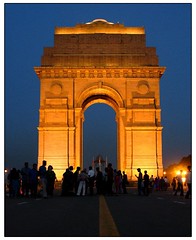| BACKGROUND | ||||||||||||||||||||||||||||||||||||||||||||||||||||||||||||||||||||||||||||||
| The civilization of India is one of the oldest civilizations in the World, spanning more than 4000 years and witnessing the rise and fall of several Empires, and projecting a unique assimilation of various cultures and heritage. The Country has always been portrayed as a land of spiritual integrity with professors of Philosophy, who have engineered the magnanimity of its nationalism. One of the oldest scriptures in the World, the four-volume Vedas that many regard as the repository of national thoughts, which have anticipated some of the modern scientific discoveries, has been created in the orb of this myth oriented Country. This strong affinity with religion and mythology has been reflected time and again through various art forms and performing arts, which are symbolical of the composite culture of India. Unity in diversity is another facet of the Country’s inherent nationalism, which had been fused by the feeling of national fervour incited by various foreign invasions that ever made its way to the Indian shores. Religious tolerance and cultural amalgamation have given shape to a uniquely secular Nation, which has created an impressive status of itself in the global arena. | ||||||||||||||||||||||||||||||||||||||||||||||||||||||||||||||||||||||||||||||
| GEOGRAPHY | ||||||||||||||||||||||||||||||||||||||||||||||||||||||||||||||||||||||||||||||
| ||||||||||||||||||||||||||||||||||||||||||||||||||||||||||||||||||||||||||||||
skip to main |
skip to sidebar

This Blog Is Related With Current Updates About All Happening Around Us.
Hit Counter
Tuesday, December 15, 2009
Home
![]() India
India
![]() India at a Glance - Geography
India at a Glance - Geography
India at a Glance - Geography
Subscribe to:
Post Comments (Atom)
It's Me

FEEDJIT Live Traffic Map
Visitors Location
FEEDJIT Live Page Popularity
Your Title
Blog Archive
-
►
2011
(1)
- ► 02/06 - 02/13 (1)
-
►
2010
(127)
- ► 08/01 - 08/08 (1)
- ► 05/23 - 05/30 (2)
- ► 04/25 - 05/02 (2)
- ► 03/28 - 04/04 (1)
- ► 03/14 - 03/21 (3)
- ► 03/07 - 03/14 (2)
- ► 02/14 - 02/21 (5)
- ► 02/07 - 02/14 (4)
- ► 01/31 - 02/07 (12)
- ► 01/24 - 01/31 (29)
- ► 01/17 - 01/24 (14)
- ► 01/10 - 01/17 (16)
- ► 01/03 - 01/10 (36)
-
▼
2009
(250)
- ► 12/27 - 01/03 (16)
- ► 12/20 - 12/27 (22)
-
▼
12/13 - 12/20
(54)
- Swine influenza
- List of Olympic sports
- Summer Olympic Games
- Seven Natural Wonders of the WorldSi...
- New7Wonders Foundation's seven wonders
- Wonders of the World
- Top 10 Car Colors
- Basic General Knowledge Quiz
- Glimpses of World History
- VICE-PRESIDENTS OF INDIA
- Indian Flag Code of Conduct
- Everyday Science Questions Answered - Part 1
- Everyday Science Questions Answered - Part 1
- General knowledge Series
- General knowledge Series
- General knowledge Series
- General knowledge Series
- General knowledge Series
- General knowledge Series
- General knowledge Series
- General knowledge Series
- General knowledge quiz questions 2
- General knowledge quiz questions 1
- General knowledge quiz questions.
- Right to Information Act
- NASA
- International Space Station
- Liberation Tigers of Tamil Eelam
- Brief Introduction Of Indian Economy
- Indian People & Goverment
- India at a Glance - Geography
- DOCOMO, Tata Unveil New Brand for GSM Service in I...
- India has Almost 500 mln Mobile Users
- Jaswant book ban: SC issues notice to Gujarat govt
- US data gives world markets hope
- India's Nobel connections
- Kakodkar ignoring facts on N-tests, says Santhanam
- CBI rules out rape, murder in Shopian case, files ...
- Chandrayaan-1
- Polar Satellite Launch Vehicle
- India successfully tests nuclear-capable missile D...
- Rural Employment Generation Programme (REGP)
- Prime Minister's Rozgar Yojana (PMRY)
- Planning Commission (India)
- National Knowledge Commission
- Shah-nawaz Committee
- Ashok Mehta Committee
- Balwant Rai Mehta Committee
- Nanavati commission
- Shah-Nanavati commission
- 2002 Gujarat violence
- Mandal Commission
- Liberhan Commission
- Miss Gibraltar crowned Miss World' 09
- ► 12/06 - 12/13 (157)
- ► 11/29 - 12/06 (1)
wibiya widget
Search This Blog
Online now
The Original
Rate my Blog
Blog List I follow
-
-
-
-
Inland Waterways in India14 years ago
-
-
Some Useful Links
3-D Visitor Locator
Categories
- Amazing facts (10)
- Automobile (5)
- Awards (5)
- Bits Of Questions (20)
- Breaking News (11)
- Bussiness (8)
- Commenwealth games 2010 (3)
- Commission (18)
- Computer world (11)
- Cricket (6)
- Current Affarirs (15)
- Defence Power (32)
- E - Books (1)
- Economy (11)
- General Sciences Questions (2)
- Geography Special (20)
- GK (77)
- Global Warming (5)
- Health (4)
- Hindi (1)
- History Special (15)
- IAS Special (14)
- India (14)
- India With Other Countries (3)
- Indian polity (7)
- Miscellaneous (7)
- Nobel Prize (5)
- Olympic Games (2)
- Quizes (10)
- Science (3)
- Short notes (17)
- Space (6)
- Telangana (6)
- Telecom (7)
- US Special (7)
- World's Wonder (3)
Link for Download Magazines and E-books
Click for The Section
Followers
Copyright 2009. IAS - EK LAKSHAY - WPBoxedTech Theme Design by Technology Tricks for Health Coupons.
Bloggerized by Free Blogger Template - Sponsored by Graphic ZONe and Technology Info
Bloggerized by Free Blogger Template - Sponsored by Graphic ZONe and Technology Info

0 comments: on "India at a Glance - Geography"
Post a Comment